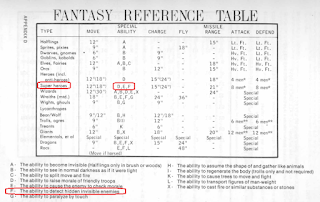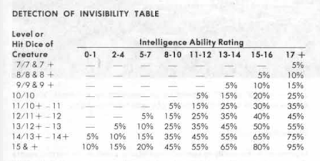Consider the O/AD&D Superhero -- a.k.a, the 8th-level Fighter. If you blink you'll miss it, but in multiple places in early texts it says that fighters of that level can automatically see invisible enemies. (!)
Here's the Fantasy Reference Table from the Chainmail game (included by reference in multiple parts of Original D&D), with key parts highlighted:
Now, you might possibly think that's a typo or something, except that it gets restated in Original D&D, Vol-2 (the Monsters & Treasures booklet), specifically in the entry for Pixies:
PIXIES: Air sprites as described in CHAINMAIL, Pixies can be made visible, or make themselves visible, but they are naturally invisible to human eyes. Therefore, they are able to attack while remaining generally invisible. They can be seen clearly only when a spell to make them visible is employed, although certain monsters such as Dragons and high-level fighters will be aware of their presence.A few years later, the Advanced D&D game generalized this ability, such that any high-level creature had some chance of detecting invisible. However, the chances of success are much reduced. For example, the 8th-level Superhero fighter now needs a very high Intelligence score, specifically 15 or higher, to have even a 5% chance of detecting invisible in a given round. Here's this table from the 1E DMG p. 60:
This seems like an odd rule: counterintuitive, easy to forget, unlikely to come into play in most games. And under the interpretation seemingly shared by the earliest designers -- that OD&D and AD&D were a single continuous game undergoing some evolution -- this seems like a case where Gygax was quickly becoming disenchanted with the rule; radically dialing down the likelihood for standard high-level fighters, for example. I take this as evidence that the clear intent was to largely take the ability away from standard Superheroes after some amount of playtest experience in D&D. (And of course this general rule was sufficiently fragile that it disappeared in later editions.)
Separately: As usual for O/AD&D, if you disentangle the numbers in that 1E table, you'll find that the progression on each axis is mostly linear. You could get a good approximation of that rule by doing the following:
Roll 1d20 + Level + Intelligence and score 40 or more.Or in Target 20 terms: roll d20 + Level + Intelligence - 20 and get a total of at least 20.
But would you want to use such a rule?










I wouldn't for D&D proper, but I think for mass combat I'd be willing to assume that by 8th Level a fighter has some magic thingummy that would do it: a sword that detects enemies or some such
ReplyDeleteIt's worth noting that the character won't actually see the invisible opponent, just be aware of its presence due to air disturbance, keen hearing or smell. It sounds a bit like spidey-sense. Also, even if a character detects the invisible creature the -4 attack penalty remains.
ReplyDeleteWe used it a little bit when we had characters of high enough level, but it didn't seem to make a huge difference in gameplay.
It sounds very Conanesque. IIRC, there is a scene in the dungeons of Tsotha-lanti where Conan fights an invisible demon-thing, not by sight so much as by sixth sense. There are other examples of such in the old fantasy pulps and Conan pastiches.
ReplyDeleteI’ve always interpreted the ability along the same lines as described in the above comments by Alan and James. I usually port the Chainmail ability over in my house-ruled OD&D games because of the entry on Pixies that you cited. No rolls to detect. Superheroes are simply aware of (or “sense” or are alerted to) invisible opponents within 30 ft of their position. My personal preference would not be to attach a roll to the ability; although, I can see the appeal of your suggestion for some in that any level fighter could attempt to detect/sense invisible opponents. But for me, I prefer to keep it as an acquired ability over time with experience. Once the fighter reaches 8th level, it’s a persistent ability (assuming the fighter is conscious) that captures that fighter’s honed fighting senses.
ReplyDeleteI lean towards Josh's interpretation. But I guess it could be the basis for an OED Blindfighting Feat.
ReplyDeleteI think there's justification for it in fiction. IIRC Benedict from Zelazny's Amber series could fight invisible enemies by some combination of heightened senses and anticipating where they must be. Maybe in OED this could be an advanced feat, only available at levels 8+.
ReplyDeleteAlan's point is most germane. Detecting the presence of something is not the same as seeing it directly, but still a huge benefit. I'd totally play it that way.
ReplyDeleteIn common with folks above, this looks to me like a genre emulation rule. "Superhero"-level fighters, your Conans and John Carters and so forth, are able to fight even invisible foes in the stories, defend themselves in pitch darkness, etc. Due to their supremely heightened fighting abilities and keen senses.
ReplyDeleteAnd yes, it looks like Gary decided to tone it down/make heroes less heroic in AD&D, which was a common trend of his in the OD&D to AD&D transition.
I like this rule for fighters, and I've been using it for a while now. I let fighters of 8th+ level automatically sense the presence of invisible enemies that come within 40' of them, they can target and attack them normally in melee at no penalty, and they can even target and shoot at them in missile combat at only −2.
ReplyDeleteEven spammers can be correct some of the time
ReplyDeleteI never played OD&D, so I am speaking here only of the AD&D version. I always played it as a "sensing" of an opponent, or of "something". Over time, I'd let players make a second roll, save vs. magic and give them a better "sense": "you feel like you are being watched by someone far off" (scrying), "it's as if someone was moving around you" (invisibility), etc... but never actually told them exactly what it was.
ReplyDeleteAnd we did use it, because it actually it's easy to remember: a 7th level/HD charactercan sense invisible at 5% if he has Int 17, and each added level increases his chances by 5% (and reduces the threshold under at which he will have the initial 5% chance. Presumably, a 7th level character with Int 18 would have a 10% chance, and the DM would have to determine whether a 6th level character had a 5% chance with Int 18. Actually easy to remember.